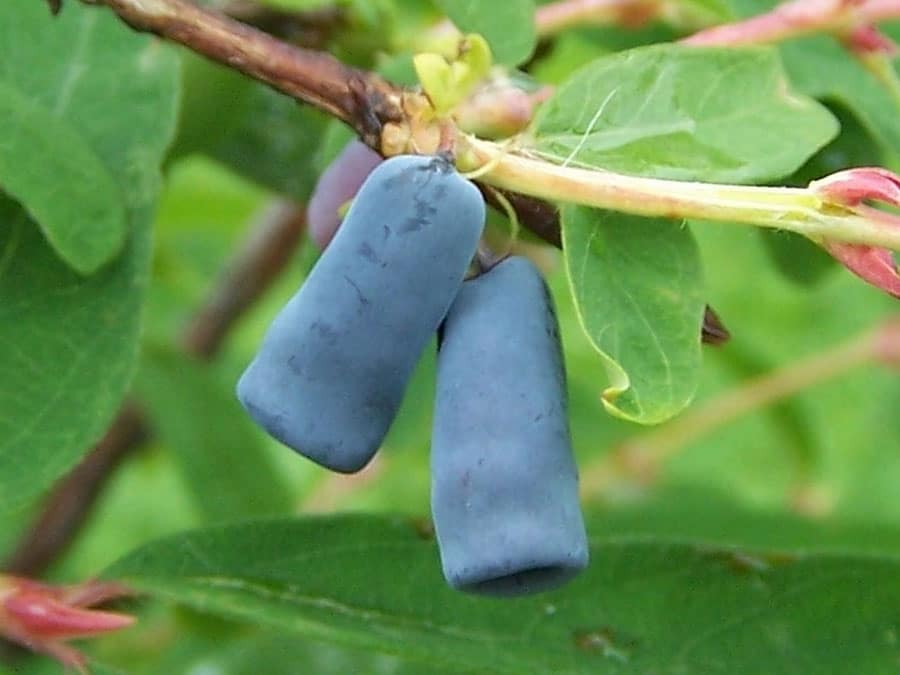
It’s an oddly shaped, purple-blue berry that is native to northern Russia, northern Japan and parts of Canada, but now also grows wild from Alberta to Newfoundland and in northeastern Europe. It’s touted as having high levels of vitamin C and antioxidants, and is more popular in many other parts of the world because of its distinctive flavour. Meet the blue honeysuckle (Lonicera caerulea), also known perhaps most commonly as haskap. Whatever you call it, this hardy, easygoing shrub with the unique-tasting berries is gaining fans here.
Trying to describe the flavour of haskaps is challenging. Some compare it to a cross between raspberries and grapes, while others find it similar to black currents. Older varieties from Russia and Japan tend to be more tart than newer cultivars, which have been selected for their delicious, sweet-tangy taste.
Bob Bors, director of the University of Saskatchewan fruit program, is wildly enthusiastic about haskaps for many reasons, including their unique taste and hardiness (Zone 2). These thornless shrubs don’t sucker and need little pruning—mainly just to tidy mature plants, he says. Bors and his team of researchers are continually trialling and developing new cultivars of the berry, breeding for taste, size and other qualities.
Haskaps prefer fertile, well-drained soil and full sun, says Madeleine Bradette of Honeyberry Hurst Farm in Nova Scotia. The five- to seven-foot (1.5- to 2.5-m) shrubs flourish in soil pH ranging from 5.5 up to 7.5, says Bors. Planting can be done from spring to early October, and any good garden compost will provide enough nutrients for the growing plants.
Although plants may bloom as early as a month before the last spring frost, haskap flowers can survive –7°C without damage, and the haskap shrub routinely survives –40°C winters. They’re generally disease- and pest-free, too. The biggest pest problem Bors encounters is songbirds such as waxwings eating the fruit.
At least two different compatible varieties are needed for good cross-pollination, and both Bors and Bradette stress choosing varieties with similar bloom times for optimal pollination. While the plants will begin fruiting the year after planting, they will produce heavier crops after several years.
It’s important to be patient when harvesting the berries—their skins turn purple-blue about a week before the interior flesh has changed from green to purple, indicating they are properly ripe—explains Bors. Depending on where you live, the early varieties of these berries can be ready to pick from the end of May to late June—ahead of all other berry and fruit crops. Half a dozen plants yield enough for plenty of fresh berries with some left over for freezing.
Haskaps in hand
Bob Bors of the University of Saskatchewan recommends the following varieties from his breeding program.
- ‘Tundra’—large (.05 ounce/1.5 g), sweet and tangy berries
- ‘Borealis’— another large-fruited variety, said to be sweeter than other varieties.
- ‘Aurora’—large (.07 ounce/2 g) sweet berries on tall, productive shrubs; a new variety for 2013 that should be widely available in spring 2014.
Haskaps to market
Haskaps also have the potential to be a great early-season crop for farmers and market gardeners. “From a commercial farmer’s point of view, it’s a good crop because it ripens earlier than any other fruit,” Bob Bors says. “It gives producers an early cash flow while waiting for other berries and fruit to ripen.”
Honeyberry Hurst Farm in Nova Scotia has 40,000 haskap bushes, with more being planted yearly, says Madeline Bradette. The farm has partnered with other Nova Scotia businesses to produce wine, beer, designer ice cream and jam. The berries freeze extremely well, and are delicious eaten straight from the freezer.
